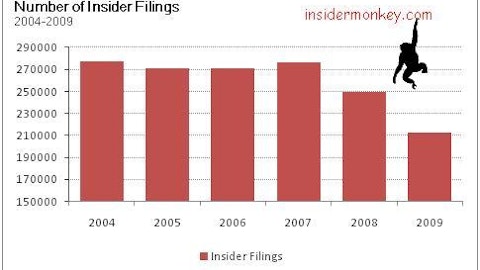Find the first part of this article here: Insider Trading Anomaly: Make 7 Percent More Than Index Funds
In 1986 University of Michigan professor Nejat Seyhun used a better methodology to measure abornormal returns. He incorporated the “size effect”. In his sample, insiders in small firms had predominantly more purchases than sales. Insider Monkey also observes the same pattern in our dataset: 60% of transactions are made by insiders in small firms, even though in dollar terms this corresponds to only 16% of all transactions. Seyhun found abnormal returns of 4.3% for the first 300 days for firms with more insider purchases than sales, and -2.2% in the same period for firms with more insider sales than purchases. He noted that employing intensive trading criteria yielded similar results.
Studies conducted until around this time were based on random subsets of insider transactions . Remember, they didn’t have comprehensive databases or powerful computers like those that are available now. More recently, studies utilize the entire insider transactions dataset and remove any remaining doubts about the profitability of insider trading.
In 2001, University of Illinois at Urbana Champaigne’s Josef Lakonishok and Inmoo Lee corrected for size and B/M effects by using a different trading criterion. They too concluded that the difference between strong buy and strong sell portfolios, which excluded transactions of large shareholders, is 4.8% for the first year after the transactions. They didn’t find any abnormal returns for large shareholders. (See Insider Trading Returns Calculated by Josef Lakonishok and Inmoo Lee)
Two years later, Harvard University’s Leslie A. Jeng and Richard Zeckhauser and Yale University’s Andrew Metrick calculated insiders’ actual returns for their purchases and sales. They didn’t use any sort of screening criteria such as consensus or “intensive purchases” that are used by other researchers. They also started calculating returns as soon as an insider made a transaction, not when the transaction become public. They found that insider sales are not profitable but insider purchases are extremely so. In raw returns, insider purchases beat the market returns by 11.2% per year.
And this return is not risk adjusted. By comparison, when a mutual fund announces they beat the market by more than 10%, they’re aren’t adjusting for risk either. The risk adjusted excess returns for the Harvard profs’ study are 52 basis points per month (or 6.4% annualized) using Carhart’s four factor model (Risk adjusted returns are 8.5% if you use CAPM to adjust for risk). Achieving 6.4% annualized returns without utilizing a consensus criteria is insane. And unbelievably, they found that purchases in small firms don’t earn significantly higher returns than do purchases in large firms.
It’s been empirically shown that insider trading has beaten the market indexes over the past 50 years. Academic studies have been publicizing this for 40 years. Yet, the markets aren’t efficient enough yet to eliminate these abnormal returns. Insider Monkey, your source for free insider trading data, believes that it’s still possible to beat market indexes and achieve abnormal returns in the long run by utilizing insider trading data.
Markets aren’t as efficient as you think.
Stay tuned: Profitability of Insider Trading in Netherlands
Related Articles:
Is Insider Trading Legal?
How Insiders Use Private Information and Don’t Get Caught?
SEC Regulation on Insider Trading: Section 10b

